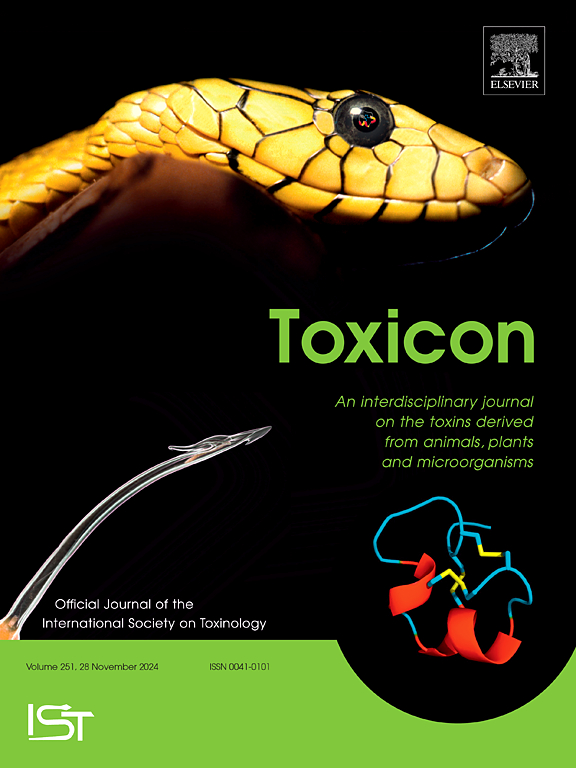Plant-derived secondary metabolites against Bothrops envenomation: A review
IF 2.6
4区 医学
Q2 PHARMACOLOGY & PHARMACY
引用次数: 0
Abstract
Snakebites from the Bothrops genus are a public health issue in Brazil, particularly in the most affected rural areas. Traditional medicinal plants offer potential complementary therapies for mitigating the damages caused by Bothrops envenomation. This review summarizes current research on the antiophidic potential in medicinal plants and its secondary metabolites to neutralize Bothrops venom effects. A comprehensive literature search was conducted to identify studies detailing the biochemical mechanisms and pharmacological effects of plant-based secondary metabolites, including polyphenols, saponins, quinones, sulfated polysaccharides, steroids, coumarins, alkaloids, and coumestans, on venom-induced pathologies. Polyphenols, particularly flavonoids, exhibit significant inhibitory activity against the proteolytic, hemorrhagic, and myotoxic effects of Bothrops venom by binding to active sites of metalloproteinases and phospholipase A2 (PLA2) Saponins and quinones demonstrated anti-inflammatory and anti-myotoxic effects through protein precipitation and ion chelation. Sulfated polysaccharides from marine algae showed anticoagulant and anti-edematous properties. Additionally, plant-derived steroids and coumarins inhibited venom-induced coagulation and tissue necrosis. Alkaloids and coumestans, such as wedelolactone, effectively reduced hemorrhagic and neurotoxic damage. Medicinal plants and their secondary metabolites have substantial potential to neutralize the biological responses of bothropic venom. Further research and clinical validation are needed to establish safety, efficacy, and standardized use in snakebite management protocols.

植物源次生代谢物抗草蓟马毒杀研究进展
在巴西,尤其是在受影响最严重的农村地区,蛇类咬伤是一个公共卫生问题。传统药用植物提供了潜在的辅助疗法,可减轻两栖类蛇咬伤造成的损害。本综述总结了目前关于药用植物及其次生代谢物在中和大脚金龟子毒液影响方面的抗蛇毒潜力的研究。我们进行了全面的文献检索,以确定有关植物次生代谢物(包括多酚、皂苷、醌类、硫酸化多糖、类固醇、香豆素、生物碱和香豆素)对毒液诱发病症的生化机制和药理作用的详细研究。多酚类物质,尤其是黄酮类物质,通过与金属蛋白酶和磷脂酶 A2(PLA2)的活性位点结合,对两栖类毒液的蛋白水解、出血和肌毒性作用具有显著的抑制活性。海藻中的硫酸化多糖具有抗凝血和抗风湿的特性。此外,植物提取的类固醇和香豆素可抑制毒液引起的凝血和组织坏死。生物碱和香豆素(如蟛蜞菊内酯)可有效减少出血和神经毒性损伤。药用植物及其次生代谢物在中和两栖类毒液的生物反应方面具有巨大潜力。需要进一步研究和临床验证,以确定其安全性、有效性以及在蛇咬伤处理方案中的标准化使用。
本文章由计算机程序翻译,如有差异,请以英文原文为准。
求助全文
约1分钟内获得全文
求助全文
来源期刊

Toxicon
医学-毒理学
CiteScore
4.80
自引率
10.70%
发文量
358
审稿时长
68 days
期刊介绍:
Toxicon has an open access mirror Toxicon: X, sharing the same aims and scope, editorial team, submission system and rigorous peer review. An introductory offer Toxicon: X - full waiver of the Open Access fee.
Toxicon''s "aims and scope" are to publish:
-articles containing the results of original research on problems related to toxins derived from animals, plants and microorganisms
-papers on novel findings related to the chemical, pharmacological, toxicological, and immunological properties of natural toxins
-molecular biological studies of toxins and other genes from poisonous and venomous organisms that advance understanding of the role or function of toxins
-clinical observations on poisoning and envenoming where a new therapeutic principle has been proposed or a decidedly superior clinical result has been obtained.
-material on the use of toxins as tools in studying biological processes and material on subjects related to venom and antivenom problems.
-articles on the translational application of toxins, for example as drugs and insecticides
-epidemiological studies on envenoming or poisoning, so long as they highlight a previously unrecognised medical problem or provide insight into the prevention or medical treatment of envenoming or poisoning. Retrospective surveys of hospital records, especially those lacking species identification, will not be considered for publication. Properly designed prospective community-based surveys are strongly encouraged.
-articles describing well-known activities of venoms, such as antibacterial, anticancer, and analgesic activities of arachnid venoms, without any attempt to define the mechanism of action or purify the active component, will not be considered for publication in Toxicon.
-review articles on problems related to toxinology.
To encourage the exchange of ideas, sections of the journal may be devoted to Short Communications, Letters to the Editor and activities of the affiliated societies.
 求助内容:
求助内容: 应助结果提醒方式:
应助结果提醒方式:


